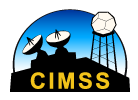On 12 August a fire in the state of Washington was investigated for possibly producing a pyroCb. This fire located around 46 N 121.5 W, and showed signs of deep convection and possibly a pyroCb. GOES-15 detected the smoke plume and pyroCb cloud, as well as the fire hot spot. Starting at 18:00 UTC on 12 August, the animation below shows visible (.63 μm) on the left and shortwave IR (3.9 μm) on the right (click image to play animation). In the shortwave IR images the red pixels indicate very hot IR brightness temperatures exhibited by the fire source region.

GOES-15 0.63 µm visible channel (left) and 3.9 µm shortwave IR channel images (right) (click to play animation)
In addition, using GOES-15 10.7 μm IR channel the cloud-top IR brightness temperature could be found. The animation below, starting at 18:00 UTC on 12 August, shows the brightness temperature -51.3ºC around 18:30 UTC (yellow color enhancement).
To further investigate the transport of smoke from this fire CALIPSO was used. This LIDAR shows the height of the clouds from the wildfire. The first image below is the 532nm Total Attenuated Backscatter plot on 12 August from 10:07 UTC to 10:30 UTC, which is about 8 hours before the pyroCb formed but smoke can still be seen in the area. The smoke from this fire can be seen extending from 46 N to 48 N indicated by a red color. The second image is 1064 nm Total Attenuated Backscatter plot, the smoke on this plot is indicated by a red color. The third image is the Depolarization image the smoke is indicated by a blue color. The fourth image is the Attenuated Ratio plot between 1064 nm and 532 nm. The smoke is indicated by the magenta pixels. The fifth image is the Vertical Feature Mask. This plot shows the different features that are in the atmosphere, the smoke is attributed as a cloud on this plot and is indicated by a light blue color. The last image shows the subtype of the aerosols that have been detected by the LIDAR. This shows that the aerosols that the LIDAR has detected are smoke (indicated by the black pixels) extending from 46 N to 48 N.

























![NOAA-18 AVHRR 0.63 µm visible (upper left), 3.7 µm shortwave IR (upper right), 10.8 µm IR (lower left), and false-color RGB image (lower right) [click to enlarge]](http://pyrocb.ssec.wisc.edu/wp-content/uploads/2015/07/20150731_0139utc_N18_ch1_ch3_ch4_ch321_Stouts_Fire.jpg)

![Suomi NPP VIIRS 3.74 µµ shortwave IR, 0.8 µm Day/Night Band, and 11.45 µm IR images [click to enlarge]](http://pyrocb.ssec.wisc.edu/wp-content/uploads/2015/07/150731_1028utc_suomi_npp_viirs_swir_dnb_ir_Stouts_Fire_OR_anim.gif)
![Suomi NPP VIIRS true-color image at 1832 UTC on 31 July [click to enlarge]](http://pyrocb.ssec.wisc.edu/wp-content/uploads/2015/07/150731_1832utc_viirs_truecolor_Stouts_Fire_smoke.png)
![Suomi NPP VIIRS true-color image at 2013 UTC on 31 July [click to enlarge]](http://pyrocb.ssec.wisc.edu/wp-content/uploads/2015/07/150731_2013utc_viirs_truecolor_Stouts_Fire_smoke.png)
![HYSPLIT forward trajectories [click to enlarge]](http://pyrocb.ssec.wisc.edu/wp-content/uploads/2015/07/150731_00utc_Stouts_Fire_trajectories.gif)
![Suomi NPP OMPS Aerosol Index on 31 July [click to enlarge]](http://pyrocb.ssec.wisc.edu/wp-content/uploads/2015/07/150731_OMPS_AI_Stouts_Fire.jpg)



















